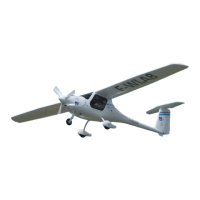3-15
ALPHA Trainer LSA
Pilot Operating Handbook
POH-162-00-40-001
PAGE REV. 0
PAGE
SECTION 3
EMERGENCY PROCEDURES
CAUTION: Expected impact in a fully stabilized deployment is equivalent
to a drop from approximately 3 meters.
Once it is decided to deploy BPRS, the following actions should be taken:
1 Airspeed MINIMUM POSSIBLE
NOTE: The maximum demonstrated deployment speed is 170 TAS.
Reducing airspeed allows minimum parachute loads and prevents
structural overload and possible parachute failure.
2
MAG L / MAG R Switches
(If time and altitude permit)
OFF
Generally, a distressed airplane will be safer for its occupants if the
engine is not running.
3 Activation Handle PULL
Pull the activation T-handle from its holder. Pull down/forward on handle
with both hands in a strong, steady, and continuous motion. Maintain max-
imum pull force until the rocket activates.
NOTE: Pull handle strongly at least 30 centimeters to make sure activation
is successful.
WARNING:!Rapidly pulling the activation T-handle will greatly increase
the pull forces required to activate the rocket. Use a firm and steady pulling
motion.
After Deployment:
4 Fuel Valve CLOSED
5 Booster pump OFF
Shutting o fuel supply to engine will reduce the chances of fire
resulting from impact at touchdown.
6 Master BAT & Master GEN OFF
7 ELT ACTIVATE
8 Seat Belts and Harnesses TIGHTEN
All occupants must have seat belts securely fastened.
9 Loose Items SECURE
If time permits, all loose items should be secured to prevent injury from
flying objects in the cabin at touchdown.
10 Assume emergency landing body position

